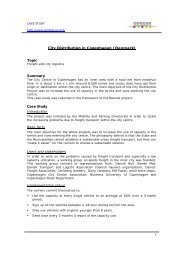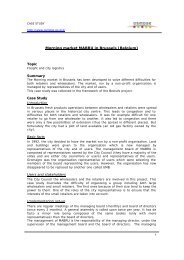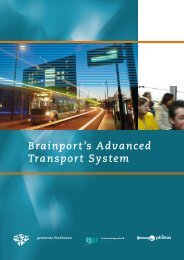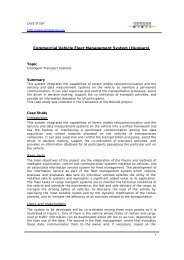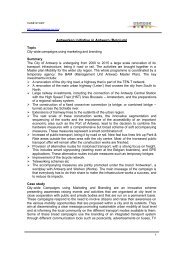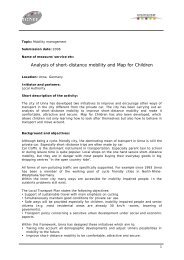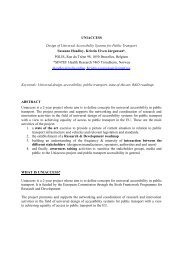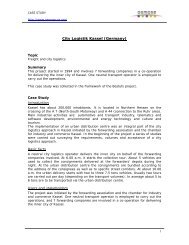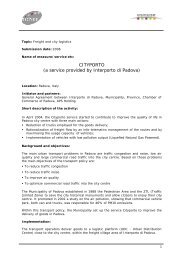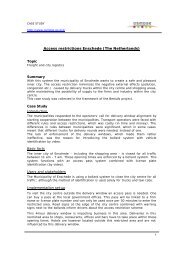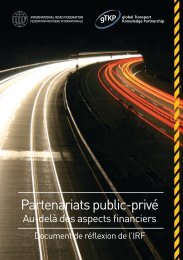The EIB's role in financing sustainable urban transport projects
The EIB's role in financing sustainable urban transport projects
The EIB's role in financing sustainable urban transport projects
Create successful ePaper yourself
Turn your PDF publications into a flip-book with our unique Google optimized e-Paper software.
Sectoral summary sheet<br />
European Investment Bank • European Investment Bank • European Investment Bank • European Investment Bank • European Investment Bank<br />
<strong>The</strong> EIB’s <strong>role</strong> <strong>in</strong> f<strong>in</strong>anc<strong>in</strong>g susta<strong>in</strong>able<br />
<strong>urban</strong> <strong>transport</strong> <strong>projects</strong><br />
<strong>The</strong> European Investment Bank was created <strong>in</strong> 1958 by the Treaty of Rome to f<strong>in</strong>ance <strong>projects</strong><br />
support<strong>in</strong>g the economic and social priorities of the European Union. Currently these priorities<br />
are: economic and social cohesion and convergence <strong>in</strong> the enlarged Union; the implementation<br />
of the knowledge economy; the development of trans-European networks (TENs); support for<br />
SMEs <strong>in</strong> the enlarged Union; protect<strong>in</strong>g and improv<strong>in</strong>g the environment and promot<strong>in</strong>g susta<strong>in</strong>able<br />
communities; and support<strong>in</strong>g susta<strong>in</strong>able, competitive and secure energy. Outside the<br />
Union, EIB lend<strong>in</strong>g is governed by a series of mandates from the European Union promot<strong>in</strong>g EU<br />
development and cooperation policies <strong>in</strong> partner countries.
European Investment Bank • European Investment Bank • European Investment Bank • European Investment Bank • European Investment Bank<br />
2 Sectoral summary sheet • <strong>The</strong> EIB’s <strong>role</strong> <strong>in</strong> f<strong>in</strong>anc<strong>in</strong>g susta<strong>in</strong>able <strong>urban</strong> <strong>transport</strong> <strong>projects</strong>
European Investment Bank • European Investment Bank • European Investment Bank • European Investment Bank • European Investment Bank<br />
To qualify for f<strong>in</strong>ancial support from the<br />
EIB, any project needs to be proven to be<br />
susta<strong>in</strong>able from both the environmental<br />
and economic standpo<strong>in</strong>ts. This is typically<br />
the case with <strong>in</strong>vestments enhanc<strong>in</strong>g<br />
public <strong>transport</strong> networks. By promot<strong>in</strong>g<br />
a shift from private to public <strong>transport</strong><br />
and seek<strong>in</strong>g to reduce congestion, such<br />
<strong>projects</strong> not only aim to improve air quality<br />
and decrease noise nuisance, but also<br />
help to tackle climate change by enhanc<strong>in</strong>g<br />
energy efficiency and limit<strong>in</strong>g greenhouse<br />
gas (GHG) emissions. In short, they<br />
contribute to improv<strong>in</strong>g the quality of<br />
life. In this sense, EIB f<strong>in</strong>anc<strong>in</strong>g for susta<strong>in</strong>able<br />
<strong>urban</strong> <strong>transport</strong> supports European<br />
Union <strong>transport</strong>, environmental and<br />
energy policies.<br />
Urban <strong>transport</strong> <strong>projects</strong> are, however, not<br />
environmentally neutral themselves, and<br />
a major feature of the Bank’s appraisal process<br />
is to check that the net environmental<br />
impact of every project is acceptable and<br />
that suitable mitigation and compensat<strong>in</strong>g<br />
measures are properly identified.<br />
<strong>The</strong> EIB <strong>in</strong> the public <strong>urban</strong><br />
<strong>transport</strong> sector<br />
Case Study: Metro de Barcelona – Línea 9<br />
<strong>The</strong> project consists of the construction of a new metro l<strong>in</strong>e (“Línea 9”,<br />
49 km <strong>in</strong> total length and 53 stations), form<strong>in</strong>g part of the underground<br />
network <strong>in</strong> the city of Barcelona and <strong>in</strong>terconnect<strong>in</strong>g five municipalities<br />
<strong>in</strong> the surround<strong>in</strong>g metropolitan area. Línea 9 is the centrepiece of the<br />
city’s public <strong>transport</strong>ation development strategy, whose objective is<br />
to create an efficient, high-capacity, public <strong>transport</strong> <strong>in</strong>frastructure to<br />
serve the <strong>in</strong>creas<strong>in</strong>g demand from sub<strong>urban</strong> locations. It will also significantly<br />
improve the l<strong>in</strong>ks between Barcelona’s <strong>in</strong>ternational airport<br />
and the city centre and will be connected twice with the Madrid – Barcelona<br />
– France high-speed rail l<strong>in</strong>k.<br />
<strong>The</strong>re is always an element of uncerta<strong>in</strong>ty when it comes to bor<strong>in</strong>g<br />
underground tunnels. In order to m<strong>in</strong>imise problems, the promoter<br />
decided to develop a model to control <strong>in</strong> real time the progress of the<br />
shield-tunnell<strong>in</strong>g mach<strong>in</strong>es. Moreover, the Bank asked for an exhaustive<br />
analysis to be carried out, tak<strong>in</strong>g <strong>in</strong>to consideration <strong>in</strong> a structured<br />
manner, all risks that could affect the project and focus<strong>in</strong>g <strong>in</strong> particular<br />
on the potential negative social impact. It was thus felt necessary to<br />
quantify the costs aris<strong>in</strong>g from the need to deploy non-conventional<br />
preventive measures, <strong>in</strong> order to reduce the risk of ground movement.<br />
<strong>The</strong> Bank considers this to be the most appropriate approach and, even<br />
though the capital cost of the project has <strong>in</strong>creased the importance of<br />
the project and its context justify the assumption of the extra costs,<br />
which will have the advantage of significantly reduc<strong>in</strong>g the level of<br />
construction risk and prevent<strong>in</strong>g undesirable delays <strong>in</strong> implementation<br />
(the project is expected to be completed by 2014).<br />
In 2008, the EIB lent EUR 57.6 billion for<br />
capi tal <strong>in</strong>vestment <strong>projects</strong>, over 89% of<br />
which was <strong>in</strong> the European Union and<br />
the rema<strong>in</strong>der <strong>in</strong> partner countries. Urban<br />
<strong>transport</strong> accounted for EUR 2.8 billion,<br />
about a fifth of EIB direct lend<strong>in</strong>g <strong>in</strong> the<br />
<strong>transport</strong> sector as a whole and 6% of total<br />
<strong>in</strong>dividual loans. Although the loan volume<br />
go<strong>in</strong>g to <strong>urban</strong> <strong>transport</strong> varies annually<br />
and accord<strong>in</strong>g to country and EIB lend<strong>in</strong>g<br />
is based more on demand than on quotas,<br />
this proportion has rema<strong>in</strong>ed similar over<br />
the last five years. Consequently, it is rare to<br />
come across a high-quality metro or light<br />
rail project <strong>in</strong> the European Union that has<br />
not received fund<strong>in</strong>g from the EIB.<br />
Between 2004 and 2008, EIB support for<br />
the <strong>urban</strong> <strong>transport</strong> sector amounted<br />
to over EUR 14 billion of direct f<strong>in</strong>anc<strong>in</strong>g.<br />
Some 69 <strong>urban</strong> <strong>transport</strong> <strong>projects</strong><br />
Sectoral summary sheet • <strong>The</strong> EIB’s <strong>role</strong> <strong>in</strong> f<strong>in</strong>anc<strong>in</strong>g susta<strong>in</strong>able <strong>urban</strong> <strong>transport</strong> <strong>projects</strong><br />
3
European Investment Bank • European Investment Bank • European Investment Bank • European Investment Bank • European Investment Bank<br />
were f<strong>in</strong>anced, of which 61 were located<br />
<strong>in</strong> the EU. <strong>The</strong>se <strong>in</strong>cluded the construction,<br />
extension or rehabilitation of public<br />
<strong>transport</strong> <strong>in</strong>frastructure (metro, light rail<br />
or tramway systems) and the acquisition<br />
of roll<strong>in</strong>g stock <strong>in</strong> capital cities (London,<br />
Athens, Madrid, Sofia and Belgrade, for<br />
example) and other major towns (Barcelona,<br />
Valencia, Malaga, Marseille, Florence,<br />
Gdansk, Istanbul, etc.).<br />
In the five-year period between 2004 and<br />
2008, most of the Bank’s lend<strong>in</strong>g for public<br />
<strong>transport</strong> went to Spa<strong>in</strong>: EUR 4.8 billion<br />
(34%), with the construction of new metro<br />
l<strong>in</strong>es <strong>in</strong> Madrid, Barcelona and Seville tak<strong>in</strong>g<br />
up the lion’s share. Urban <strong>transport</strong><br />
<strong>projects</strong> <strong>in</strong> France accounted for over<br />
EUR 2.3 billion (17%), for <strong>projects</strong> such as<br />
the extension of the Toulouse metro or<br />
the construction of new tramway l<strong>in</strong>es <strong>in</strong><br />
Paris, Nice, Le Mans, Toulon or Clermont-<br />
Ferrand, and EUR 500 million went on a<br />
programme support<strong>in</strong>g local authorities<br />
<strong>in</strong>vest<strong>in</strong>g <strong>in</strong> susta<strong>in</strong>able <strong>urban</strong> <strong>transport</strong>.<br />
Loans <strong>in</strong> the United K<strong>in</strong>gdom came to<br />
EUR 1.3 billion (9%), of which over EUR 650<br />
million went on the construction and<br />
operation of the East London L<strong>in</strong>e.<br />
Outside the EU, where EIB lend<strong>in</strong>g for public<br />
<strong>urban</strong> <strong>transport</strong> totalled EUR 1.6 billion<br />
over the last five years, the Bank has played<br />
a significant <strong>role</strong> <strong>in</strong> f<strong>in</strong>anc<strong>in</strong>g <strong>urban</strong> mass<br />
transit <strong>in</strong> cities such as Istanbul, Bursa and<br />
Antalya <strong>in</strong> Turkey.<br />
F<strong>in</strong>anc<strong>in</strong>g <strong>urban</strong> public<br />
<strong>transport</strong>ation<br />
A major challenge for the EIB’s <strong>in</strong>volvement<br />
<strong>in</strong> public <strong>transport</strong> is to support solutions<br />
that strike a balance between the grow<strong>in</strong>g<br />
demand for mobility and the quality of<br />
the <strong>urban</strong> environment. Particularly <strong>in</strong> the<br />
new Member States and the Pre-accession<br />
countries, this entails limits on the <strong>in</strong>discrim<strong>in</strong>ate<br />
proliferation of new <strong>in</strong>frastructure<br />
and leads to the implementation of<br />
rational long-term plann<strong>in</strong>g processes.<br />
2004-2008 – EIB <strong>in</strong>dividual loans <strong>in</strong> the <strong>urban</strong> <strong>transport</strong> sector: EUR 13.6 billion<br />
Portugal 2.06%<br />
Poland 2.11%<br />
Austria 2.06%<br />
Hungary 7.23%<br />
0.56% Romania<br />
9.16% United K<strong>in</strong>gdom<br />
Italy 6.18%<br />
11.44% Turkey<br />
1.60% Belgium<br />
France 16.58%<br />
1.00% Bulgaria<br />
1.69% Czech Republic<br />
0.27% Germany<br />
0.23% Estonia<br />
Spa<strong>in</strong> 34.03%<br />
5.70% Greece<br />
4 Sectoral summary sheet • <strong>The</strong> EIB’s <strong>role</strong> <strong>in</strong> f<strong>in</strong>anc<strong>in</strong>g susta<strong>in</strong>able <strong>urban</strong> <strong>transport</strong> <strong>projects</strong>
European Investment Bank • European Investment Bank • European Investment Bank • European Investment Bank • European Investment Bank<br />
Unfortunately, <strong>urban</strong> public <strong>transport</strong><br />
<strong>projects</strong> are only rarely f<strong>in</strong>ancially selfsupport<strong>in</strong>g<br />
and usually face substantial<br />
operat<strong>in</strong>g deficits. Typically, tariffs<br />
have to be at acceptable levels, because<br />
mobility is considered a common good<br />
and public <strong>transport</strong> is used as a tool<br />
for <strong>in</strong>come redistribution. Nevertheless,<br />
even if the f<strong>in</strong>ancial rate of return is negative,<br />
the project may still show a robust<br />
economic rate of return and meet the<br />
EIB’s requirements.<br />
To meet their f<strong>in</strong>anc<strong>in</strong>g needs, both for<br />
new <strong>in</strong>vestment and to cover operat<strong>in</strong>g<br />
deficits, most cities use a comparatively<br />
discretionary contribution from<br />
central, regional and municipal governments.<br />
However, there is a grow<strong>in</strong>g need<br />
for new approaches to mobilis<strong>in</strong>g the<br />
required f<strong>in</strong>ancial resources, not only<br />
to ensure a quality service, but also to<br />
<strong>in</strong>crease the supply of services to meet<br />
chang<strong>in</strong>g societal needs. Here the EIB<br />
can play an important <strong>role</strong>.<br />
Apprais<strong>in</strong>g <strong>projects</strong> with a view to<br />
f<strong>in</strong>anc<strong>in</strong>g them<br />
As part of the appraisal of public <strong>transport</strong><br />
<strong>in</strong>vestment plans, the EIB considers the<br />
structur<strong>in</strong>g and general coord<strong>in</strong>ation of the<br />
operation from a f<strong>in</strong>ancial po<strong>in</strong>t of view. If<br />
needed, it will provide technical assistance<br />
to the project promoter to ensure that the<br />
operation is feasible and fundable. This<br />
requires carry<strong>in</strong>g out a detailed analysis of<br />
the risks associated with the various phases<br />
of the project (design, procurement, construction<br />
and operation).<br />
To that end, the EIB will consider the various<br />
stakeholders <strong>in</strong>volved <strong>in</strong> the operation,<br />
the potential risks and ways of<br />
m<strong>in</strong>imis<strong>in</strong>g those risks.<br />
Aga<strong>in</strong>st this backdrop, the EIB conducts<br />
a thorough analysis of each project, and<br />
its technical experts prepare an appraisal<br />
report that <strong>in</strong>cludes:<br />
• the justification for EIB fund<strong>in</strong>g (EU poli cy<br />
objectives served);<br />
• additional favourable factors (e.g. the<br />
<strong>in</strong>novative nature of the <strong>in</strong>vestment);<br />
• the key risks;<br />
• recommendations to the borrower, miscellaneous<br />
comments, service life;<br />
• the general terms and conditions applicable<br />
to the loan and its disbursement;<br />
• supervision of the contract by the EIB (type,<br />
content and frequency of report<strong>in</strong>g);<br />
• a general assessment of the environmental<br />
as well as social impact on the people<br />
who will be affected.<br />
To sum up, before a decision is taken to<br />
f<strong>in</strong>ance a project, the EIB has to establish<br />
that the project is viable from an economic,<br />
f<strong>in</strong>ancial, technical and environmental<br />
po<strong>in</strong>t of view. A promoter <strong>in</strong>terested <strong>in</strong><br />
obta<strong>in</strong><strong>in</strong>g a loan from the Bank will therefore<br />
have to prepare adequate documentation<br />
that allows the Bank to analyse the<br />
various project-related issues. In addition,<br />
the EIB always carries out an on-site visit<br />
Sectoral summary sheet • <strong>The</strong> EIB’s <strong>role</strong> <strong>in</strong> f<strong>in</strong>anc<strong>in</strong>g susta<strong>in</strong>able <strong>urban</strong> <strong>transport</strong> <strong>projects</strong><br />
5
European Investment Bank • European Investment Bank • European Investment Bank • European Investment Bank • European Investment Bank<br />
with the promoter <strong>in</strong> order to ensure that<br />
the project appraisal is as objective and<br />
comprehensive as possible.<br />
Fund<strong>in</strong>g <strong>urban</strong> public <strong>transport</strong><br />
<strong>projects</strong> through public-private<br />
partnerships at the EIB<br />
<strong>The</strong> number of <strong>projects</strong> funded through<br />
public-private partnerships (PPPs) is<br />
constantly <strong>in</strong>creas<strong>in</strong>g. <strong>The</strong> vast majority<br />
of the EIB’s PPP lend<strong>in</strong>g is <strong>in</strong> the <strong>transport</strong><br />
sector, <strong>in</strong>clud<strong>in</strong>g <strong>urban</strong> <strong>transport</strong>.<br />
EIB support for <strong>urban</strong> <strong>transport</strong> PPPs<br />
between 2004 and 2008 amounted to<br />
EUR 3.5 billion.<br />
<strong>The</strong> ma<strong>in</strong> attraction of PPPs lies <strong>in</strong> the<br />
<strong>in</strong>creased efficiency and effectiveness<br />
achieved by shar<strong>in</strong>g a project’s risks. Risks<br />
should be shouldered by those best able<br />
to manage them: the construction and<br />
operational risks are borne by the private<br />
enterprise, while public authorities<br />
take on the responsibility for establish<strong>in</strong>g<br />
and ma<strong>in</strong>ta<strong>in</strong><strong>in</strong>g a balanced legal<br />
and economic framework throughout<br />
the life of the project. In addition, PPPs<br />
enable public authorities to create public<br />
service <strong>in</strong>frastructure, while stagger<strong>in</strong>g<br />
the burden of their <strong>in</strong>vestment over<br />
time and, <strong>in</strong> certa<strong>in</strong> cases, allow<strong>in</strong>g offbalance<br />
sheet commitments.<br />
Successful PPPs <strong>in</strong>volve a close partnership<br />
between the parties <strong>in</strong>volved, while<br />
keep<strong>in</strong>g a constant eye on the f<strong>in</strong>al customer.<br />
<strong>The</strong> public authorities and the<br />
private concession-holder must have a<br />
clear grasp of the project’s scope, both<br />
<strong>in</strong> terms of its purpose (public service)<br />
and its duration (long-term). Given all<br />
of these factors, the EIB normally analyses<br />
public <strong>transport</strong> PPPs <strong>in</strong> two dist<strong>in</strong>ct<br />
stages. Firstly, dur<strong>in</strong>g the preparation<br />
of the bidd<strong>in</strong>g specifications, the Bank<br />
assists the developer with the f<strong>in</strong>ancial<br />
organisation of the <strong>in</strong>vitation to tender.<br />
Secondly, it validates the viability of the<br />
operation once the concession-holder<br />
has been selected and provides the necessary<br />
f<strong>in</strong>ance.<br />
<strong>The</strong> Bank works <strong>in</strong> close cooperation<br />
with all the ma<strong>in</strong> players: the European<br />
<strong>in</strong>stitutions, public authorities and the<br />
private sector. To meet this challenge,<br />
the EIB has a dedicated <strong>in</strong>ter-directorate<br />
unit for giv<strong>in</strong>g advice and transferr<strong>in</strong>g<br />
know-how on the structur<strong>in</strong>g of PPPs. In<br />
addition, alongside national and regional<br />
PPP authorities and the European Commission,<br />
the EIB is an active participant <strong>in</strong><br />
the recently created European PPP Expertise<br />
Centre (EPEC), which will facilitate<br />
the shar<strong>in</strong>g of experience among public<br />
sector PPP authorities with<strong>in</strong> Europe<br />
and provide practical PPP implementation<br />
assistance. <strong>The</strong> EIB is committed<br />
to a partnership with all the stakeholders<br />
<strong>in</strong>volved <strong>in</strong> <strong>urban</strong> public <strong>transport</strong><br />
<strong>projects</strong>, whether PPPs or more conventional<br />
structures. It makes sure that its<br />
considerable f<strong>in</strong>ancial resources are used<br />
<strong>in</strong> the best possible way to enhance the<br />
quality of life of Europe’s citizens.<br />
6 Sectoral summary sheet • <strong>The</strong> EIB’s <strong>role</strong> <strong>in</strong> f<strong>in</strong>anc<strong>in</strong>g susta<strong>in</strong>able <strong>urban</strong> <strong>transport</strong> <strong>projects</strong>
European Investment Bank • European Investment Bank • European Investment Bank • European Investment Bank • European Investment Bank<br />
EIB support for the Covenant of Mayors <strong>in</strong>itiative<br />
<strong>The</strong> European Investment Bank has agreed to support the Covenant<br />
of Mayors <strong>in</strong>itiative, contribut<strong>in</strong>g to its development and towards<br />
f<strong>in</strong>anc<strong>in</strong>g the necessary <strong>in</strong>vestments <strong>in</strong> energy efficiency and renewables<br />
technologies to make cities greener.<br />
A number of EIB f<strong>in</strong>ancial <strong>in</strong>struments can be applied to support this<br />
<strong>in</strong>itiative, <strong>in</strong>clud<strong>in</strong>g:<br />
• <strong>in</strong>dividual loans to f<strong>in</strong>ance large <strong>projects</strong> (or groups of <strong>projects</strong><br />
promoted/implemented by the same entity);<br />
• <strong>in</strong>struments to f<strong>in</strong>ance small-scale <strong>in</strong>vestments <strong>in</strong> collaboration with<br />
the local bank<strong>in</strong>g sector;<br />
• a comb<strong>in</strong>ation of grants and loans, when subsidies are available and<br />
needed to overcome important barriers.<br />
In sectoral terms, the ma<strong>in</strong> focus at this stage is on energy efficiency<br />
and renewable energy <strong>in</strong> public build<strong>in</strong>gs, social hous<strong>in</strong>g, street<br />
light<strong>in</strong>g and <strong>urban</strong> <strong>transport</strong> (for example, energy-efficient buses).<br />
Energy Service Companies (ESCOs) are expected to play a substantial<br />
<strong>role</strong> <strong>in</strong> implement<strong>in</strong>g <strong>in</strong>vestments <strong>in</strong> these areas.<br />
In this context, the Bank has recently established a Clean Bus Framework<br />
F<strong>in</strong>ance Facility (CBFF) to provide advantageous long-term f<strong>in</strong>anc<strong>in</strong>g<br />
to <strong>urban</strong> <strong>transport</strong> operators replac<strong>in</strong>g or expand<strong>in</strong>g their bus fleets<br />
with new vehicles that exceed exist<strong>in</strong>g environmental requirements,<br />
especially buses that run on alternative fuels, hybrids or buses that use<br />
other clean technologies.<br />
<strong>The</strong> EIB is work<strong>in</strong>g with the European Commission to set up a grant<br />
facility to support the preparation of <strong>projects</strong>. This facility would be<br />
available to cities or groups of cities that have specific, sufficiently large<br />
<strong>in</strong>vestment programmes to implement the objectives of the Covenant.<br />
Project proposals would normally be considered for <strong>in</strong>vestment programmes<br />
of EUR 100m or more; however, proposals <strong>in</strong>volv<strong>in</strong>g smaller<br />
amounts may also be considered.<br />
<strong>The</strong>se advisory services could cover measures aimed at enhanc<strong>in</strong>g local<br />
capacity for project development, <strong>in</strong>clud<strong>in</strong>g the preparation of the<br />
tender<strong>in</strong>g process. <strong>The</strong> goal is to support the development of <strong>projects</strong><br />
present<strong>in</strong>g <strong>in</strong>novative solutions or that will serve as a demonstration to<br />
others. <strong>The</strong>se advisory services should result <strong>in</strong> the implementation of<br />
<strong>in</strong>vestments directly related to the objectives of action plans prepared<br />
under the Covenant of Mayors.<br />
Cities or groups of cities are <strong>in</strong>vited to contact the EIB for a pre lim<strong>in</strong>ary<br />
discussion on their <strong>in</strong>vestment plans (contact: covenant.of.<br />
mayors@eib.org).<br />
Sectoral summary sheet • <strong>The</strong> EIB’s <strong>role</strong> <strong>in</strong> f<strong>in</strong>anc<strong>in</strong>g susta<strong>in</strong>able <strong>urban</strong> <strong>transport</strong> <strong>projects</strong><br />
7
Sectoral summary sheet • <strong>The</strong> EIB’s <strong>role</strong> <strong>in</strong> f<strong>in</strong>anc<strong>in</strong>g susta<strong>in</strong>able <strong>urban</strong> <strong>transport</strong> <strong>projects</strong><br />
European Investment Bank • European Investment Bank • European Investment Bank • European Investment Bank • European Investment Bank<br />
Contacts<br />
For general <strong>in</strong>formation:<br />
Information Desk<br />
Communication Department<br />
3 (+352) 43 79 - 22000<br />
5 (+352) 43 79 - 62000<br />
U <strong>in</strong>fo@eib.org<br />
For press <strong>in</strong>quiries:<br />
Press Office Secretariat<br />
Communication Department<br />
3 (+352) 43 79 - 21000<br />
5 (+352) 43 79 - 62000<br />
U press@eib.org<br />
European Investment Bank<br />
98-100, boulevard Konrad Adenauer<br />
L-2950 Luxembourg<br />
3 (+352) 43 79 - 1<br />
5 (+352) 43 77 04<br />
www.eib.org – <strong>in</strong>fo@eib.org<br />
© EIB – 02/2009 – QH-80-09-525-EN-C © EIB Graphic Workshop<br />
Photo: IFERCAT



